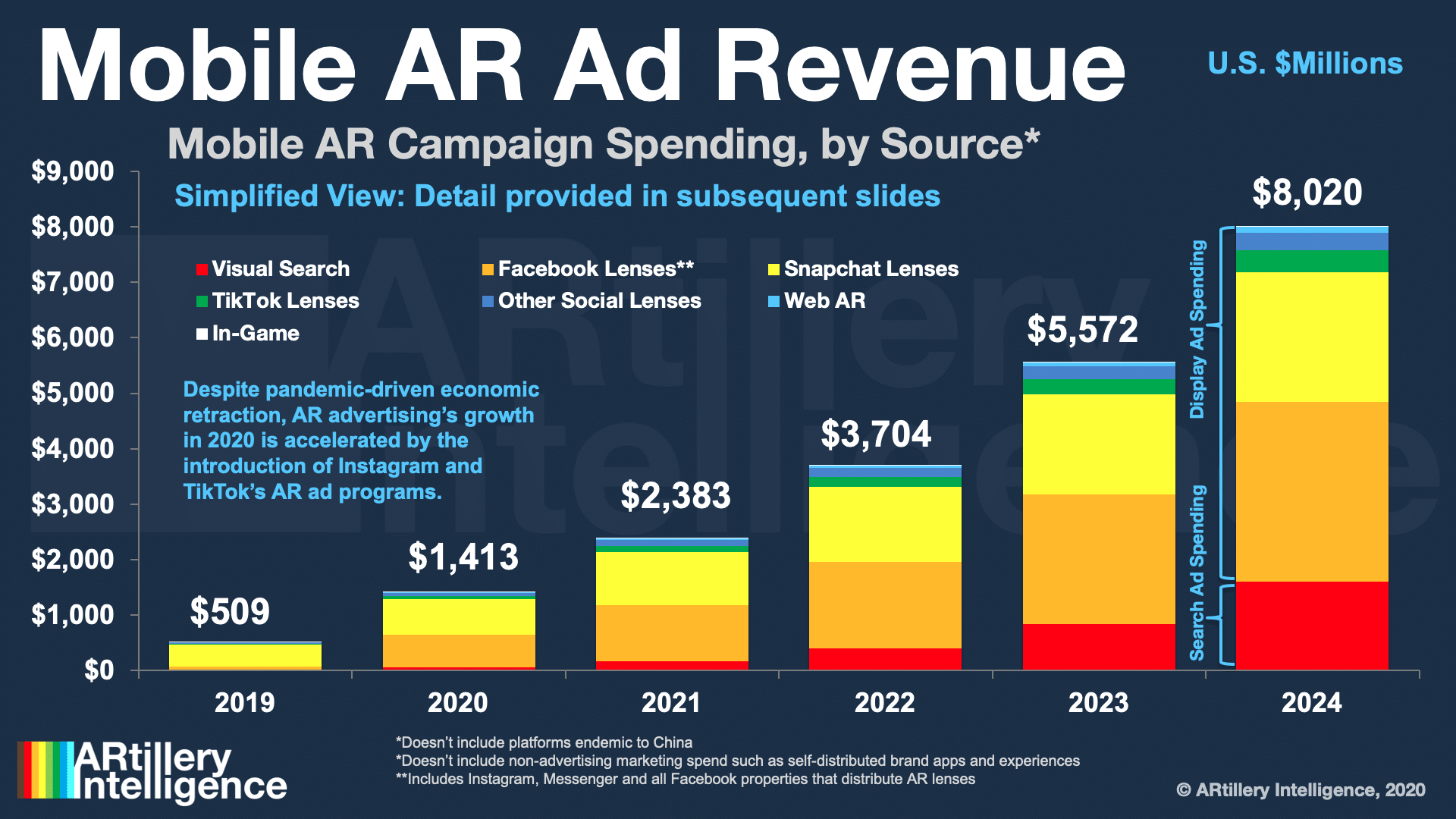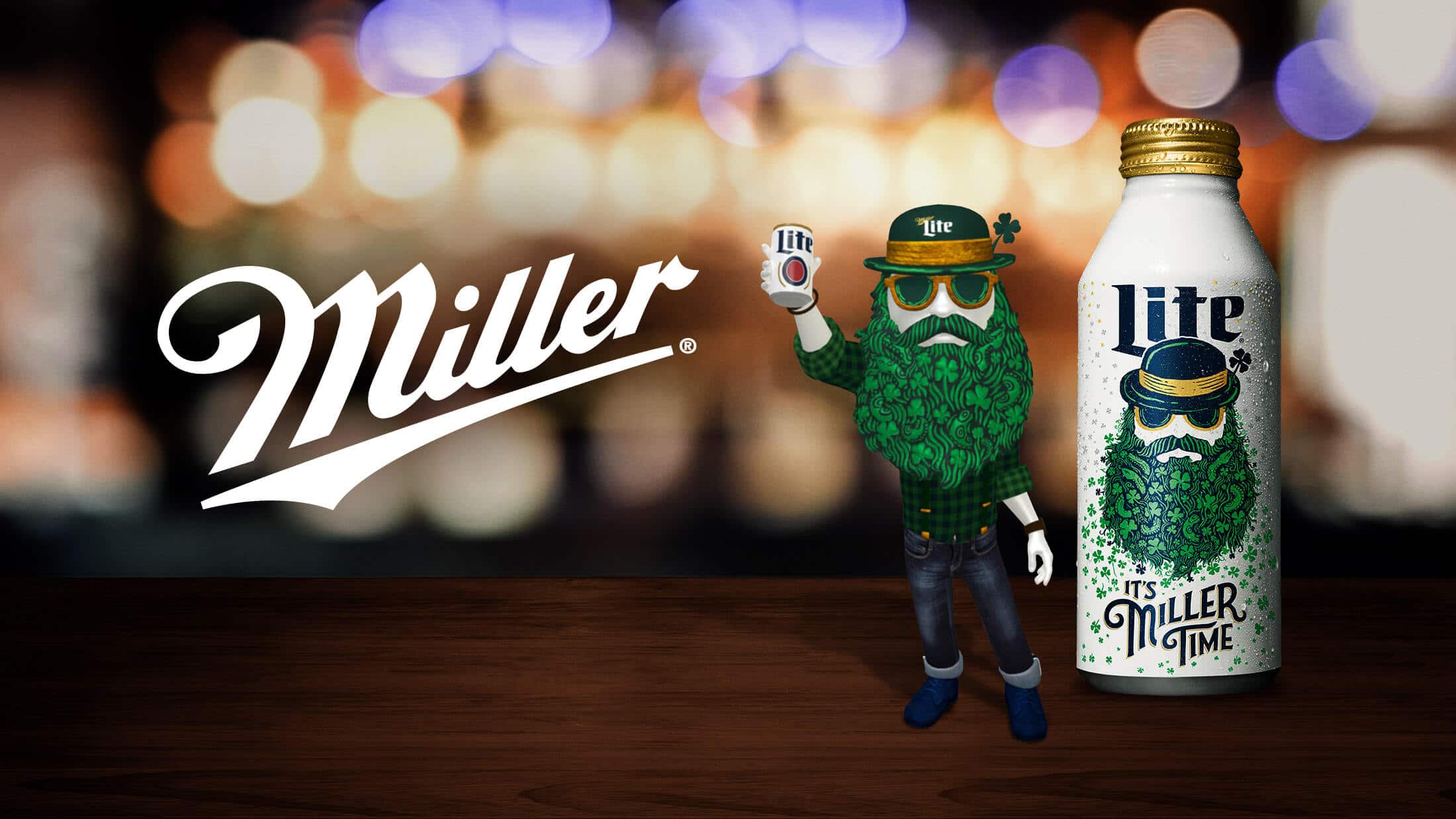
AR continues to evolve and take shape as an industry. Prominent sectors include industrial AR, social, gaming, and shopping. But existing alongside all of them is AR advertising. This includes paid/sponsored AR lenses that let consumers visualize products on “spaces & faces.”
Advertising is one of the most lucrative AR subsectors, on pace to reach $1.41 billion this year and $8.02 billion by 2024. These figures measure the money spent on sponsored AR experiences with paid distribution on networks like Facebook and Snapchat.
As our research arm ARtillery Intelligence examined in a recent report on AR advertising, adoption drivers include brand advertisers’ growing affinity for AR. Its ability to demonstrate products in 3D resonates with their creative sensibilities, transcending common 2D formats.
To continue the narrative and “show rather than tell,” part II of that report features case studies that map to various stages of the consumer purchase funnel. What do AR ads look like today, what’s the concrete ROI, and what are strategic takeaways for campaign execution?

Miller Time
After a few case studies that focused on upper-funnel AR ad campaigns, we now move to the mid-funnel. These campaign strategies include AR-based games; experiences that link to a product page; experiences that drive high “dwell-times”; or other indicators of consumer engagement.
One such example comes from Miller Lite’s St. Patrick’s Day campaign last year. The multi-dimensional campaign included a Unity-built AR portal that let users enter an immersive Irish-themed (and beer-themed) world, and an AR coin-toss drinking game.
Separately, the web AR portion of the campaign, powered by 8th Wall, launched animations when users pointed their phones at designated markers on Miller Lite cans and packaging. The animations featured the campaign’s protagonist, the “Bearded Man,” in various hijinx.
This all happened pre-Covid, so the campaign dynamics and results reflect those conditions. But there are still strategic takeaways for AR campaign strategies, and extrapolating AR’s role in a post-Covid world where its value and consumer acclimation could accelerate.

Favorable Outcome
And the results? The AR portal had a 28 percent engagement rate, compared with a 20 percent benchmark for non-branded AR experiences. 93 percent of users completed the portal tour, which exceeded historic benchmarks that are about 40 percent.
The coin toss game had a 75 percent re-engagement rate, indicating AR’s potential for replayability. There was also a 25 percent lift in Miller Lite “favorability” versus typical St. Patrick’s Day fare (think: Guinness); and session lengths with the Bearded Man averaged 3 minutes.
The results speak for themselves in outperforming non-AR benchmarks. One highlight is the 25 percent favorability lift, given that the campaign’s main objective was to elevate Miller Lite’s seasonal affinity. The challenge was doing so for a beer that’s not endemic to St. Patrick’s Day.
Another thing we’ll underscore from the results is the 3+ minute session lengths. As we’ve examined, long session lengths for AR campaigns counter the notion that AR effectiveness is diminished by relatively short sessions (upheld device, arm fatigue, etc.).
Developing Competency
As for campaign strategy, Miller Coors launched the AR portal two weeks before the holiday to boost awareness. It then followed that with the bearded man AR can activation during St. Patrick’s Day weekend. And all of the above was amplified through Miller Lite’s social channels.
Meanwhile, one takeaway for consumer-facing brands, or anyone considering AR advertising, is that it’s working. Scale and reach are still relatively low, but even that’s showing signs of reaching Superbowl-sized audiences when propelled by the virality of social channels like Snapchat.
But regardless of AR’s capability and reach today, it shows enough positive signals for brands to start experimenting and developing competency for tomorrow. One lesson from the smartphone era is that those who failed to do so fell behind and lost competitive edge to those who did.
“As consumers demand more engaging and immersive experiences, brands should absolutely be thinking about incorporating AR into their marketing campaigns,” Unity’s Tony Parisi told us. “Two areas I’d recommend starting with are digitizing and storytelling. If a brand has physical products, they should start looking into creating real-time 3D assets to represent those products virtually. They don’t have to complete the full catalog, but it’s important to start so they understand the tools and processes. I also encourage brands to think about how to tell their story with AR. Whether the product is a manufactured good, a financial service, or food or beverage, there’s a story to tell – one that will be more relevant and engaging to consumers through the lens of AR.”

